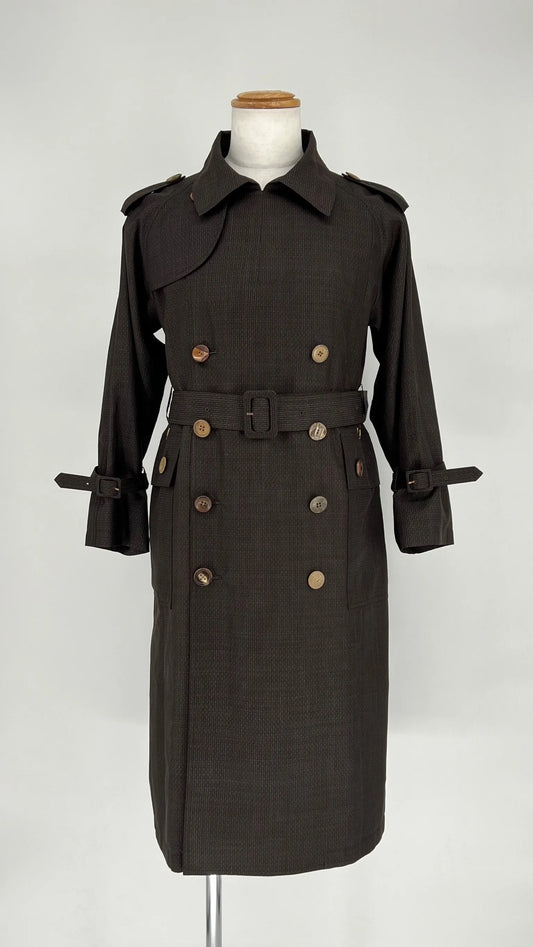Collection: Oshima Trench Coat

Value that will not change even after 100 years
An encounter with a coat that has been loved for over 100 years
Old Masterpiece
"Oshima Tsumugi" is a silk fabric that Japan is proud of, produced on Amami Oshima Island in Kagoshima Prefecture, and is counted among the world's three great textiles, alongside France's "Gobelins" and Iran's "Persian carpets."
Mud dyeing is a two-step process in which raw silk is dyed with a liquid made from the bark of the tachi tree (Teichi tree), and then soaked in a muddy field.
It can take several years to complete one bolt of this beautiful fabric, which goes through more than 30 steps in total.
Every time you move it makes a satisfying "swoosh" sound like silk rustling.
Each design and pattern has its own meaning, and one cannot help but feel the miracle that has been born from history, the local climate, and the work of our ancestors.

New Works
Trench coat.
This coat, which has a special presence among coats, was created in the UK in the early 1900s as military uniform. The name "Trench" comes from the fact that this coat was weather-resistant in the muddy trenches that were common during World War I.
According to the literature, after going through a number of model changes, a product with the name "trench coat" was created in 1915 (Taisho 4). The flaps, belts, and epaulets found throughout the product were details that were useful in a variety of situations during combat.
There is absolutely no relation between "a trench coat developed for muddy ground warfare" and "Oshima Tsumugi woven from mud-dyed silk thread." However, by combining the two using the common keyword of "mud," the result was a product that is quite interesting.
One of the main reasons for adopting Oshima Tsumugi is its characteristic strength and flexibility that remains unchanged even after 100 years.
AITTA's trench coats are a hybrid design based on both the design when the trench coat was first created and the design when it was later adopted as a fashion item.
We put our special feelings into this recipe.
Trench coats are long and come with many parts such as flaps and belts, so one kimono is not enough to make one coat.
Since I was using multiple Oshima Tsumugi kimonos, I decided to use the "crazy pattern" technique.
Our policy is to use up all the fabric without leaving any leftover, so any fabric left over from the first item will be used for the second item and beyond.
Any fabric left over from the second item will be carried over to make the third item and beyond.
We believe that this production style, which embodies the spirit of "mottainai" (waste not, want not) and a sense of playfulness, is an important one in today's world, where sustainability is valued.

The lining is made from deadstock body lining.
Even when unused, the silk lining of the body will yellow over time. This is dyed with mulberry leaves to create an eye-catching light green color.
There is a word called "ura-kakari."
This was a custom in the Edo period, particularly seen in men's kimono, of placing more flashiness and opulence on the inside than on the outside, which was sparked by the ban on luxury goods.
The uniquely Japanese aesthetic sense of hiding eye-catching colors and designs in places that cannot be seen from the outside is what we have adopted for our tailoring.
Each garment has different buttons.
We select unique buttons for each production, such as covered buttons made from the same fabric or antique French buttons that are unique to each piece.
As an option, you can choose a special button called "back protector" for the storm flap on the back.
In this case, we will suggest a piece that has been made with special care, such as "a button made from a French antique glass button with eggshell lacquer applied by a lacquer artist" or "a button made from a 1915 (Taisho 4) rising sun 50 sen silver coin fashioned into a concho shape."

We aim to tailor the exquisite Japanese fabric into a garment that can be worn comfortably.
The Oshima Tsumugi trench coat is a product that AITTA should make, and a product that only AITTA can make.








